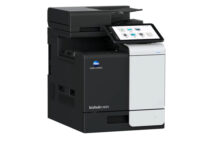To paraphrase the recent remark of a copier company CEO, the only thing that 3D printing and 2D printing have in common is the word printing. While that comment is telling, it’s not entirely true. Yes, there are vast differences between the 3D and 2D printing worlds in terms of technology and the materials the various devices consume, but they do overlap in a few interesting areas.
That overlap is important to companies in the 2D ecosystem hoping to find opportunity in the 3D industry. Before delving into where those opportunities might be, let’s review what makes 3D printing different from 2D.
Also known as “additive manufacturing,” 3D printing is used to create a diverse variety of objects ranging from simple trinkets to complex machinery to biological organs. This is in contrast to 2D printing, which essentially places writing and images on flat surfaces or “puts marks on paper,” as is often said by folks in the hardcopy industry.
What this means on the consumables side is that you have to consider factors for 3D printing that just don’t exist in the 2D world—for example, tensile strength, fit and finish, and bonding qualities. These factors and the broad variety of applications for which 3D printing is used require a wide, rich range of supplies made from an assortment of materials. Very few of these materials, however, have much in common with 2D inks and toners, although they do share certain base components.
Because of these considerations and the fact that with 3D printing you are building an object rather than printing a page, 3D hardware and software are very different from 2D technologies. That extra dimension adds an order of magnitude in complexity that requires its own unique technology. With a few exceptions, 2D technologies are of little use in 3D applications. And even those instances where 2D players have made inroads into 3D may turn out to be through applications that will prove to be transitional and in time be replaced by more specialized options.
So in the vastness of the 3D space, where can 2D companies to look for lasting opportunities? At the moment, there are four areas that hold some promise:
- providing technologies that originated in the 2D world like jetting for 3D apps;
- 3D supplies;
- 3D software; and
- sales and distribution channels.
Technologies and Supplies
Although only a handful remain in the desktop inkjet space, a number of hardcopy OEMs continue to market print heads for commercial and industrial applications and all of these companies are looking at 3D. The list includes Brother, Canon, Epson, HP, Konica Minolta, Ricoh, and Xerox.
Several firms like HP, Ricoh, and Xerox supply print heads and other technology to 3D hardware manufacturers, while others such as Brother and Epson seem likely to develop their own 3D technology. Canon and Konica Minolta have dipped their toes in the water by signing up to be resellers for the hardware manufacturer 3D Systems, and more seem likely to follow.
Of all the 2D hardware manufacturers, HP appears to be on track to be the first to market a 3D machine under its own brand. Last year, the firm announced plans to release 3D units based its homegrown MultiJet Fusion (MJF) technology, which features arrays of HP’s thermal inkjet print heads with tens of thousands of nozzles (see “HP Officially Announces Its Own 3D Printing Technology”). HP claims its machines will deliver faster print speeds and high-resolution 3D output at “breakthrough economics relative to similar systems in the marketplace today.”
Since the initial announcement, HP has been moving forward with its entrance into the 3D market. In January, the company tapped Intel to supply Intel Core i7 processors for the first MJF devices, which are expected to be available in limited quantities later this year before going into mass production next year.
Even though the core construction materials used in 3D applications are often quite alien to the 2D world, similar chemical components are used in in the production of 2D and 3D consumables especially in those 3D applications based on jetting technologies. The main categories of specialty chemicals used in the production of both hardcopy and additive manufacturing include:
- colorants;
- dispersing agents; and
- vehicle components.
Color choices in output from 3D printers have often been limited. However, this is an area where specialty-chemical providers are looking to differentiate themselves. Producers of highly engineered colorants like the pigments and dyes used in hardcopy supplies are exploring how well their products will adapt to 3D applications. With the rise of full-color 3D output, the door is now open for dispersant makers to release products for materials employed in additive manufacturing. Maintaining uniform distribution of colorants, dispersants are every bit as critical to the correct color rendering in various 3D applications as they are in 2D output.
Beyond companies marketing colorants and dispersants for inks and toners, other specialty chemical makers are also eying the 3D space. As with the inks used in inkjet printers, many 3D systems based on jetting technologies require materials like binders to be fired with great precision and formed into uniform droplets. The accuracy with which a droplet is fired can be enhanced chemically so it can be placed on a surface precisely in both 2D and 3D applications. Like inkjet inks, consumables used in 3D jetting technologies contain surfactants to control surface tension and ensure proper droplet formation.
Likewise, humectants, which are deployed to prevent inks from drying out, are used in liquids for 3D to retard premature drying. Regardless if the application is 2D or 3D, humectants play an important role in preventing print heads from becoming clogged or damaged by dried out jetting materials.
Specialty-chemical companies are finding they can leverage their existing 2D printing customer base with products for the emerging 3D printing space. Many companies manufacturing inks and toners have the chemical engineering expertise to develop precision consumables for 3D printing applications. Although the market for third-party 3D printing supplies is embryonic, it has already attracted a third-party supplies vendors. Many are flocking to China’s leading trade show for third-party supplies industry, ReChina Asia Expo, which will be held in Shanghai later this week. Dozens of firms will exhibit 3D products at the show, and some, including Jingjie Imaging, TonerParts, and UTec, will be exhibiting both 2D and 3D supplies.
Additive manufacturing has provided opportunities for a number of new companies to bring to market new 3D devices. One of these companies, the third-party supplies manufacturer Print-Rite, is distributing its machines and supplies through UTec, which as noted above is participating in the ReChina Asia Expo. Print-Rite launched its CoLiDo Desktop 3D Printer in July 2014 (see “Print-Rite Launches Desktop 3D Printer”) and markets an extensive line of consumables for the device including a new PLA and ABS composite material that consists of a mixture of wood particles to produce items with the look and smell of wood (see “Print-Rite Adds Wooden Filament Range for CoLiDo 3D Printers”). Other firms in the digital consumables industry are likely to follow Print-Rite’s lead—if not with their own hardware, then certainly with 3D supplies.
Software
Most of the professional-grade 2D modeling and design software vendors have already added 3D capabilities to their printing packages. You can now print a 3D object from Adobe Photoshop, for example, and the CAD/CAM software companies have had good integration with 3D printing systems for several years to support the rise in demand for rapid prototyping.
On the consumer side, there is a lack of fully featured, easy-to-use design and modeling software. You can find simple programs such as Google’s Sketchup, but they have limited functionality. A complete package that lets amateurs create and edit a design and then prepare a file for the 3D system that requires little training would help accelerate the consumer market for 3D printers.
Another area for opportunity is in post-modeling software, which falls into three categories:
- slicing, which takes a 3D model and translates it to individual layers that are then sent to the printer for printing;
- support structure, which generates code that the printer uses to create a physical support structure for the object being created; and
- optimization and printing, which analyzes the code for the model being sent to the printer to make sure it is rendered as efficiently as possible.
The fact that these software types exist as standalone offerings speaks to the complexity and immaturity of the software landscape for 3D printing. In the 2D world, the capabilities of these types of software such as PostScript and scalable fonts have long been integrated into the core products used to create graphics. This has not yet happened in the 3D world. The opportunity exists because the processing that takes place post modeling is often time-consuming and creates lag in an already slow printing process. The market will likely reward anyone who can find more efficient ways to execute these functions.
One issue with creating software for 3D printing is the lack of standards. Although nearly all the printer manufacturers use the same file format (STL, for stereolithography), software for one 3D system vendor probably won’t be compatible with systems from other vendors. Autodesk has taken steps to unify the 3D printing landscape with its cloud-based Spark service, which provides a set of open source APIs and services. Spark is currently in beta, and Autodesk is taking applications for beta access.
Channel
Perhaps the most direct opportunity to cross over to 3D printing is for 2D channel companies, mainly for the commercial market. Most of the major 3D printer manufacturers sell directly and through resellers including, as noted, some 2D hardware manufacturers. Some resellers and dealers moving traditional hardcopy products have expanded their business with 3D options, and many more are looking to follow suit.
This makes perfect sense because most companies large enough to have in-house 3D systems are likely to have a relationship with vendors who lease, sell, and service 2D products. Consider, for example, a manufacturer that may be using wide-format devices and other hardcopy equipment to support its R&D efforts. Dealers have the opportunity to leverage their 2D relationship to sell 3D equipment. One vendor providing equipment, supplies, and service for all output system needs is a great convenience and cost-effective for the manufacturer.
While those in the 2D channel will feel at home in the 3D market, there are some important differences. Right now it is unclear how great the aftermarket opportunity is for 3D channel partners, for example. 3D printer manufacturers market their own OEM consumables, and as is the case in in the 2D world, they aggressively protect their consumables business. In some cases, manufacturers warn that using unapproved consumables can void a warranty or a service agreement.
Similarly, 3D hardware manufacturers often limit the amount of service they will allow their channel partners to perform. This is partly to protect an important revenue stream, but there are also legitimate concerns about poor results or damaged equipment caused by poor quality consumables or shoddy maintenance and repairs.
Beyond the economic upside manufacturers enjoy when they secure supplies and service revenue, it is important to understand why 3D hardware manufacturers limit the amount of third-party involvement they will allow involving consumables sales and service delivery. The tolerances for 3D can be very exacting. The thickness and consistency of filament-type consumables, for example, must be painstakingly precise across the entire strand. If the filament diameter is off by even a miniscule amount, the equipment could jam or feed the material at the wrong rate, ruining a project. Likewise, servicing the robotics found in many 3D devices require a completely different skill set than that of even the most seasoned copier technician.
But these are early days, and the dealers and resellers currently placing office equipment, wide-format printers, and other commercial devices will find growth opportunities in the 3D market. It took decades for third-party consumables for 2D printers to achieve the level of quality now available in non-OEM toner and ink supplies.
Many in the copier and printer channels avoided third-party supplies as the quality came up to snuff. And initially there weren’t many qualified technicians available to repair the first xerographic devices that hit the market around the middle of the previous century. In time, I expect that the 3D market will grow to provide plenty of opportunities for companies marketing the hardware and supplies needed for the various applications of additive manufacturing as well as the service required to keep the machines humming.
Michael Nadeau has made a career of explaining emerging technology to business and IT professionals. He is the founding publisher of Data Informed and a veteran editor and publisher of IT publications. Michael has held senior-level positions at BYTE magazine and IDG. He currently helps IT companies and publishers master content- and data-driven marketing and social media practices. You may contact Michael at menadeau99@gmail.com.






